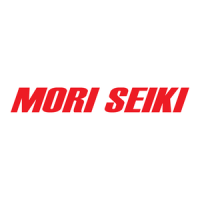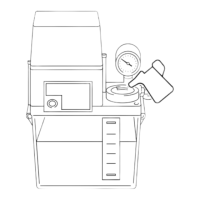Do you have a question about the mori seiki MSC-516 and is the answer not in the manual?
Explains why daily inspections are crucial for maintaining machine accuracy and performance.
Provides essential safety and hygiene measures for inspections and maintenance tasks.
Safety guidelines for performing work inside the machine, emphasizing power shutoff and precautions.
Outlines critical safety measures for operating the chip conveyor, including manual references.
Detailed procedure for safely opening the electrical cabinet door, including power shutoff.
Detailed procedure for safely closing the electrical cabinet door and securing it.
Highlights the significance of regular inspections for maintaining machine accuracy and longevity.
Lists critical safety checks and warnings to be observed before commencing maintenance work.
Covers electrical safety, operator clothing, and parameter changes for technicians.
Emphasizes cooperation, communication, using specified parts, and safe equipment handling.
Provides a troubleshooting guide for low lubricant pressure, identifying causes and actions.
Steps for disassembling, cleaning, and reassembling the relief valve.
Procedure for adjusting the relief valve to set the correct pump discharge pressure.
Details the types of batteries used for memory backup and absolute position sensing across NC units.
Continues the table of battery types and their compatibility with various NC units and manufacturers.
Procedure for replacing CNC memory back-up batteries, with emphasis on data preservation.
Specific steps for replacing Type 1 memory backup batteries, noting data loss risk.
Procedure for replacing Type 2 memory backup batteries located in the electrical cabinet.
Procedure for replacing Type 2 memory backup batteries located on the operation panel.
Procedure for replacing Type 3 (2CR5) lithium photo batteries for memory backup.
Procedure for replacing Type 4 memory backup batteries.
General procedure for replacing servo absolute position sensing batteries.
Steps for replacing Type 1 alkaline/manganese batteries for absolute position sensing.
Critical safety guidelines for mounting and removing chucks, chuck cylinders, and connection rods.
Explains why daily inspections are crucial for maintaining machine accuracy and performance.
Provides essential safety and hygiene measures for inspections and maintenance tasks.
Safety guidelines for performing work inside the machine, emphasizing power shutoff and precautions.
Outlines critical safety measures for operating the chip conveyor, including manual references.
Detailed procedure for safely opening the electrical cabinet door, including power shutoff.
Detailed procedure for safely closing the electrical cabinet door and securing it.
Highlights the significance of regular inspections for maintaining machine accuracy and longevity.
Lists critical safety checks and warnings to be observed before commencing maintenance work.
Covers electrical safety, operator clothing, and parameter changes for technicians.
Emphasizes cooperation, communication, using specified parts, and safe equipment handling.
Provides a troubleshooting guide for low lubricant pressure, identifying causes and actions.
Steps for disassembling, cleaning, and reassembling the relief valve.
Procedure for adjusting the relief valve to set the correct pump discharge pressure.
Details the types of batteries used for memory backup and absolute position sensing across NC units.
Continues the table of battery types and their compatibility with various NC units and manufacturers.
Procedure for replacing CNC memory back-up batteries, with emphasis on data preservation.
Specific steps for replacing Type 1 memory backup batteries, noting data loss risk.
Procedure for replacing Type 2 memory backup batteries located in the electrical cabinet.
Procedure for replacing Type 2 memory backup batteries located on the operation panel.
Procedure for replacing Type 3 (2CR5) lithium photo batteries for memory backup.
Procedure for replacing Type 4 memory backup batteries.
General procedure for replacing servo absolute position sensing batteries.
Steps for replacing Type 1 alkaline/manganese batteries for absolute position sensing.
Critical safety guidelines for mounting and removing chucks, chuck cylinders, and connection rods.
| Brand | mori seiki |
|---|---|
| Model | MSC-516 |
| Category | Lathe |
| Language | English |












